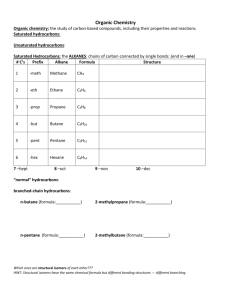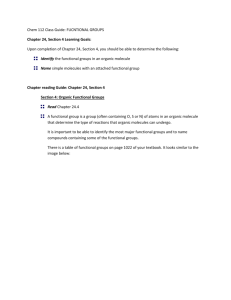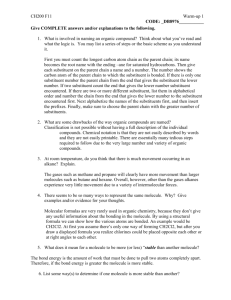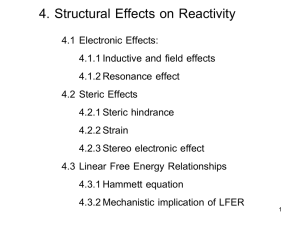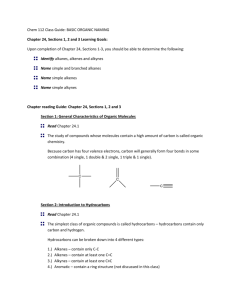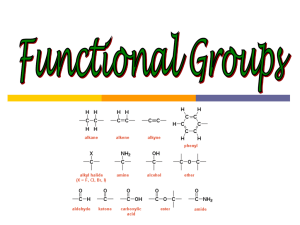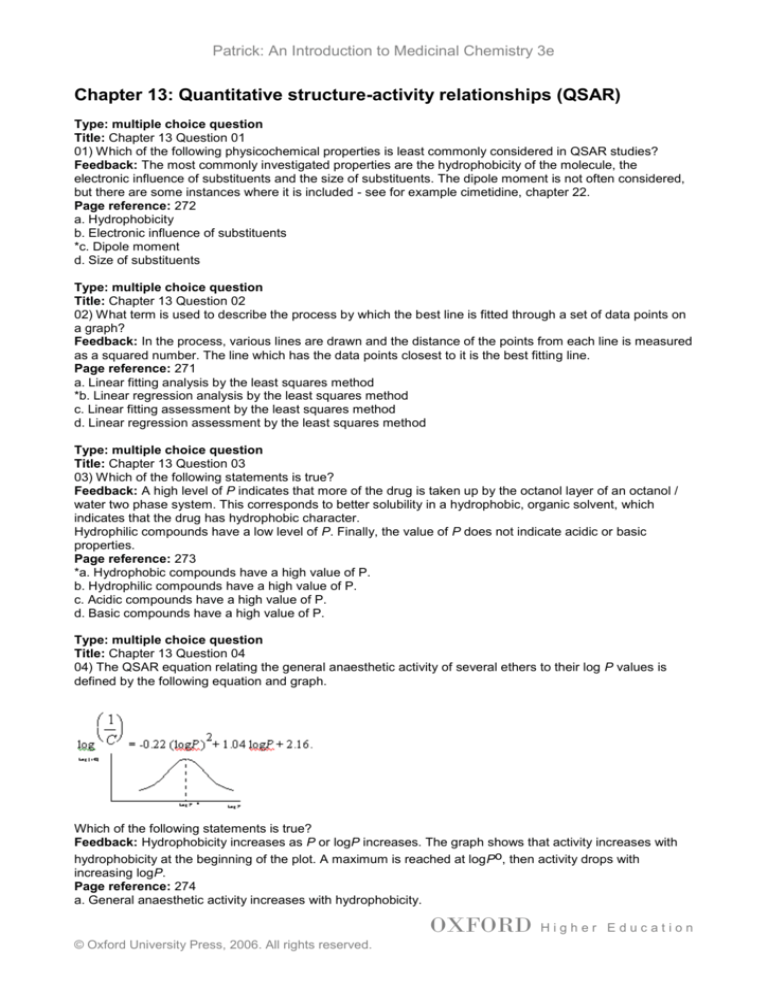
Patrick: An Introduction to Medicinal Chemistry 3e
Chapter 13: Quantitative structure-activity relationships (QSAR)
Type: multiple choice question
Title: Chapter 13 Question 01
01) Which of the following physicochemical properties is least commonly considered in QSAR studies?
Feedback: The most commonly investigated properties are the hydrophobicity of the molecule, the
electronic influence of substituents and the size of substituents. The dipole moment is not often considered,
but there are some instances where it is included - see for example cimetidine, chapter 22.
Page reference: 272
a. Hydrophobicity
b. Electronic influence of substituents
*c. Dipole moment
d. Size of substituents
Type: multiple choice question
Title: Chapter 13 Question 02
02) What term is used to describe the process by which the best line is fitted through a set of data points on
a graph?
Feedback: In the process, various lines are drawn and the distance of the points from each line is measured
as a squared number. The line which has the data points closest to it is the best fitting line.
Page reference: 271
a. Linear fitting analysis by the least squares method
*b. Linear regression analysis by the least squares method
c. Linear fitting assessment by the least squares method
d. Linear regression assessment by the least squares method
Type: multiple choice question
Title: Chapter 13 Question 03
03) Which of the following statements is true?
Feedback: A high level of P indicates that more of the drug is taken up by the octanol layer of an octanol /
water two phase system. This corresponds to better solubility in a hydrophobic, organic solvent, which
indicates that the drug has hydrophobic character.
Hydrophilic compounds have a low level of P. Finally, the value of P does not indicate acidic or basic
properties.
Page reference: 273
*a. Hydrophobic compounds have a high value of P.
b. Hydrophilic compounds have a high value of P.
c. Acidic compounds have a high value of P.
d. Basic compounds have a high value of P.
Type: multiple choice question
Title: Chapter 13 Question 04
04) The QSAR equation relating the general anaesthetic activity of several ethers to their log P values is
defined by the following equation and graph.
Which of the following statements is true?
Feedback: Hydrophobicity increases as P or logP increases. The graph shows that activity increases with
hydrophobicity at the beginning of the plot. A maximum is reached at logPo, then activity drops with
increasing logP.
Page reference: 274
a. General anaesthetic activity increases with hydrophobicity.
OXFORD
© Oxford University Press, 2006. All rights reserved.
Higher Education
Patrick: An Introduction to Medicinal Chemistry 3e
b. General anaesthetic activity decreases with hydrophobicity.
*c. General anaesthetic activity increases with hydrophobicity to a maximum value then decreases.
d. General anaesthetic activity decreases with hydrophobicity to a minimum value then decreases.
Type: multiple choice question
Title: Chapter 13 Question 05
05) The QSAR equation relating the general anaesthetic activity of several ethers to their log P values is
defined by the following equation and graph.
What is the meaning of logPo in the graph?
Feedback: The level of activity on the y-axis is maximum at the level of hydrophobicity indicated by logPo
on the x-axis.
Page reference: 274
*a. LogPo represents the value of logP which is optimum for activity.
b. LogPo represents the value of logp which is worst for activity.
c. LogPo represents the maximum hydrophobicity for the compounds tested.
d. LogPo represents the minimum hydrophobicity for the compounds tested.
Type: multiple choice question
Title: Chapter 13 Question 06
06) How is π measured?
Feedback: A positive value of π indicates that a substituent is more hydrophobic than hydrogen. A negative
value of π indicates that a substituent is less hydrophobic than hydrogen.
Page reference: 275-276
a. It is measured by calculating molecular dimensions using relevant molecular modelling software.
b. It is measured by comparing the dissociation constants of two weak acids.
c. It is measured by subtracting the logP value of an analogue bearing the substituent from the log P value
of the parent compound lacking the substituent.
*d. It is measured by subtracting the logP value of the parent compound lacking the substituent from the log
P value of an analogue bearing the substituent.
Type: multiple choice question
Title: Chapter 13 Question 07
07) Which of the following statements is true?
Feedback: A positive value of π indicates that a substituent is more hydrophobic than hydrogen. A negative
value of π indicates that a substituent is less hydrophobic than hydrogen. π has nothing to do with a
substituent's size or electronic character.
Page reference: 275
a. A positive value of π indicates that a substituent is larger than H.
b. A positive value of π indicates that a substituent is more electron donating than H.
*c. A positive value of π indicates that a substituent is more hydrophobic than H.
d. A negative value of π indicates that a substituent is more hydrophobic than H.
Type: multiple choice question
Title: Chapter 13 Question 08
08) What is the distinction between logP and π?
Feedback: Neither logP nor π have anything to do with pH, size or electronic properties.
Page reference: 276
a. logP is a measure of the overall pH of a molecule, whereas π is a measure of the hydrophobicity of a
substituent.
OXFORD
© Oxford University Press, 2006. All rights reserved.
Higher Education
Patrick: An Introduction to Medicinal Chemistry 3e
*b. logP is a measure of the overall hydrophobicity of a molecule, whereas π is a measure of the
hydrophobicity of a substituent.
c. π is a measure of the overall hydrophobicity of a molecule, whereas logP is a measure of the
hydrophobicity of a substituent.
d. logP is a measure of the overall pH of a molecule, whereas π is a measure of the electronic effect of a
substituent.
Type: multiple choice question
Title: Chapter 13 Question 09
09) What does ES represent in a QSAR equation?
Feedback: The electronic influence of a substituent is measured by , the Hammett substituent constant.
The measure of a substituent's steric properties is indicated by a variety of methods including Taft's
substituent constant Es. The entropy associated with a substituent is not normally considered in QSAR
equations.
Page reference: 279-280
a. The electronic influence of a substituent as an electron withdrawing group
b. The electronic influence of a substituent as an electron donating group
c. The entropy associated with a substituent
*d. Taft's steric factor
Type: multiple choice question
Title: Chapter 13 Question 10
10) What does MR represent in a QSAR equation?
Feedback: Molar refractivity is a steric factor determined from the index of refraction, the molecular weight
and the density.
Page reference: 280
*a. Molar refractivity as a steric factor
b. Molar refractivity as an electronic factor
c. Molar refractivity as a hydrophobic factor
d. Molar refractivity as a stereoelectronic factor
Type: multiple choice question
Title: Chapter 13 Question 11
11) What does the Hammett substituent constant () measure?
Feedback: The measure of a substituent's steric properties is indicated by a variety of methods including
Taft's substituent constant Es.
The electronic effect of a substituent is measured by , the Hammett substituent constant.
The hydrophobic effect of a substituent is measured by the substituent hydrophobicity constant π.
Page reference: 276
a. The steric effect of a substituent
*b. The electronic effect of a substituent
c. The hydrophobic effect of a substituent
d. The effect on pH of a substituent
Type: multiple choice question
Title: Chapter 13 Question 12
12) The σm value for a phenol substituent (OH) is 0.12, whereas the σp value is -0.37. What do σm and σp
stand for?
Feedback: σ is a measure of a substituent's electronic effects. The hydrophobic effect of a substituent is
measured by the substituent hydrophobicity constant π. The measure of a substituent's steric properties is
indicated by a variety of methods including Taft's substituent constant Es. σ is not a measure of a
substituent's effect on acidity.
Page reference: 278
*a. The electronic effect of the phenol substituent at the meta and para positions respectively.
b. The hydrophobic effect of the phenol substituent at the meta and para positions respectively.
c. The steric effect of the phenol substituent at the meta and para positions respectively.
d. The acidic effect of the phenol substituent at the meta and para positions respectively.
OXFORD
© Oxford University Press, 2006. All rights reserved.
Higher Education
Patrick: An Introduction to Medicinal Chemistry 3e
Type: multiple choice question
Title: Chapter 13 Question 13
13) The σm value for a phenol substituent (OH) is 0.12, whereas the σp value is -0.37. Why are σm and σp
so different?
Feedback: The Hammett substituent constant has nothing to do with steric or hydrophobic effects.
The meta substituent is closer to the rest of the molecule and has an electron withdrawing effect, but it does
not explain why the para substituent has an electron donating effect.
Page reference: 278
a. The meta substituent is closer to the rest of the molecule than the para substituent and has a greater
electron withdrawing effect.
b. The meta substituent is closer to the rest of the molecule than the para substituent and has a greater
steric effect.
c. The meta substituent is closer to the rest of the molecule than the para substituent and has a greater
hydrophobic effect.
*d. The meta substituent has an inductive effect which makes it electron withdrawing, whereas the para
substituent has a resonance effect which makes it electron donating.
Type: multiple choice question
Title: Chapter 13 Question 14
14) The QSAR equation relating the insecticidal activity of a series of diethyl phenylphosphonates versus σ
is shown below.
What does log(1/C) represent?
Feedback: The concentration is C which is included in the activity term log(1/C). The catalytic activity has
no relevance at all since these compounds are not acting as catalysts. The physiochemical is wrong since
the physicochemical properties are on the right hand side of the equation.
Page reference: 279
a. The concentration
b. The catalytic activity
*c. The insecticidal activity
d. The physicochemical property
Type: multiple choice question
Title: Chapter 13 Question 15
15) The QSAR equation relating the insecticidal activity of a series of diethyl phenylphosphonates versus σ
is shown below.
What physicochemical property is beneficial for activity?
Feedback: A positive value of σ will result in good activity and this corresponds to an electron withdrawing
substituent. The Hammett substituent constant has nothing to do with size or hydrophobicity.
Page reference: 279
a. An electron donating substituent
*b. An electron withdrawing substituent
c. A hydrophobic substituent
d. A small substituent
Type: multiple choice question
Title: Chapter 13 Question 16
16) What do the factors R and F represent in a QSAR equation?
Feedback: The factors R and F are electronic factors which distinguish a substituent's resonance electronic
effects from its inductive electronic effects. They have nothing to do with hydrophobicity.
OXFORD
© Oxford University Press, 2006. All rights reserved.
Higher Education
Patrick: An Introduction to Medicinal Chemistry 3e
Page reference: 278
a. A substituent's steric effect and hydrophobic effect respectively.
b. A substituent's inductive effect and resonance effect respectively.
*c. A substituent's resonance effect and inductive effect respectively.
d. A substituent's electronic effect and hydrophobic effect respectively.
Type: multiple choice question
Title: Chapter 13 Question 17
17) What is a Craig plot used for?
Feedback: A Craig plot compares the values of two specified physicochemical properties for a range of
substituents. This allows suitable substituents to be chosen for a QSAR study which will demonstrate a
range of values for each physicochemical property, but where the values will not be correlated to each other.
Page reference: 282-283
a. To compare the activities of different compounds having different substituents.
b. To compare the values of a specific physicochemical property for a range of substituents.
*c. To compare the values of two specified physicochemical properties for a range of substituents.
d. None of the answers are correct.
Type: multiple choice question
Title: Chapter 13 Question 18
18) What does CoMFA stand for in 3D QSAR?
Feedback: CoMFA methodology is based on the assumption that drug–receptor interactions are noncovalent and that changes in biological activity correlate with the changes in the steric and/or electrostatic
fields of the drug molecules.
Page reference: 291
a. Compound molecular formula assessment
b. Compound mass field analysis
*c. Comparative molecular field analysis
d. Comparative modelling force field analysis
Type: multiple choice question
Title: Chapter 13 Question 19
19) What two physical features (or fields) are most important in 3D QSAR studies?
Feedback: Electrostatic and steric fields are the fields normally used in 3D QSAR studies although it is
possible to have a hydrophobic field.
Page reference: 292
a. Hydrophobic and steric fields.
*b. Electrostatic and steric fields.
c. Hydrophobic and electrostatic fields.
d. Steric field and dipole moment.
Type: multiple choice question
Title: Chapter 13 Question 20
20) Which of the following is not crucial for 3D QSAR studies?
Feedback: It is crucial that each molecule in a 3D QSAR study is aligned properly. This requires knowledge
of the active conformation and the pharmacophore. Knowledge of the target structure and how the
molecules bind to it is certainly useful but it is not essential.
Page reference: 295
a. Identification of the active conformation for each molecule
b. Identification of the pharmacophore for each molecule
c. Alignment of each molecule
*d. Identification of the target structure
Type: multiple choice question
Title: Chapter 13 Question 21
21) What is the relevance of a probe atom in 3D QSAR?
Feedback: The probe atom is a positively charged atom such as a carbon or a proton which is placed at
each grid point of a lattice surrounding the test molecule. It is used to measure the steric and electronic
interactions between it and the test molecule. This in turn allows the calculation of steric and electronic fields
for each molecule in the study.
OXFORD
© Oxford University Press, 2006. All rights reserved.
Higher Education
Patrick: An Introduction to Medicinal Chemistry 3e
Page reference: 292-293
a. It is used to position a molecule into a lattice of grid points.
b. It is used to determine the position of the various grid points making up the lattice.
c. It is an atom of the test molecule which is used as a spatial reference point.
*d. It is placed at the grid points of a lattice to determine the important properties of a molecule placed in the
lattice.
Type: multiple choice question
Title: Chapter 13- Question 22
22) Which of the following figures is an acceptable value for the regression coefficient?
Feedback: A value over 0.90 is an acceptable figure for the regression coefficient.
Page reference: 282
a. 0.01
b. 0.1
c. 0.5
*d. 0.95
Type: multiple choice question
Title: Chapter 13- Question 23
23) What symbol represents the partition coefficient in a QSAR equation?
Feedback: The partition coefficient is a measure of a drug's hydrophobicity and can be measured by
comparing the relative concentrations of the drug in a two phase system of water and octanol.
pH is a measure of hydrogen ion concentration. The symbol π is used to represent the substituent
hydrophobicity constant. The symbol σ is used to represent the Hammett substituent constant.
Page reference: 273
a. pH
b. π
*c. P
d. σ
Type: multiple choice question
Title: Chapter 13- Question 24
24) Which of the following statements is true?
Feedback: The partition coefficient (P) is a measure of a drug's hydrophobicity and is low for hydrophilic
compounds.
The electronic properties and the size of a substituent are measured by the Hammett substituent constant
and a steric constant respectively. The hhydrophilic/hydrophobic property of an individual substituent is
measured by the substituent hydrophobicity constant and not the partition coefficient. The latter is a
measure of the drug's overall hydrophobicity.
Page reference: 273
*a. Hydrophilic compounds have a low value of P
b. An electron withdrawing substituent has a low value of P
c. A small substituent has a low value of P
d. A hydrophilic substituent substituent has a low value of P
Type: multiple choice question
Title: Chapter 13- Question 25
25) What symbol represents the substituent hydrophobicity constant in a QSAR equation?
Feedback: The hydrophobicity constant is a measure of how hydrophobic an individual substituent is.
The hydrophobicity of the overall molecule is measured by the partition coefficient P or logP. The electronic
effect of a substituent is measured by σ, the Hammett substituent constant. pH is a measure of hydrogen ion
concentration.
Page reference: 275
a. pH
*b. π
c. P
d. σ
Type: multiple choice question
Title: Chapter 13- Question 26
OXFORD
© Oxford University Press, 2006. All rights reserved.
Higher Education
Patrick: An Introduction to Medicinal Chemistry 3e
26) Calculate the logP value for structure (I) (logP for benzene = 2.13;
Feedback: The value is obtained by adding the
Page reference: 275
a. 1.40
b. 1.44
*c. 2.82
d. 2.86
3) -0.02)).
values for each substituent to the logP value for benzene.
Type: multiple choice question
Title: Chapter 13- Question 27
27) Given the following log P values, what is the log P value for the disubstituted structure?
Feedback: The log P values demonstrate that the hydrophobicity constants for the substituents methoxy
and fluoro are -0.02 and 0.14 respectively. This means that the log P value of the disubstituted structure will
be 2.13 + (-0.02) + 0.14 = 2.25
Page reference: 275
a. 1.97
b. 2.01
*c. 2.25
d. 2.29
Type: multiple choice question
Title: Chapter 13- Question 28
28) Which symbol is used to represent Taft's steric factor in a QSAR equation?
Feedback: MR is the symbol used to represent molar refractivity as a steric factor
R is used to represent an aromatic substituent's electronic resonance effect.
F is used to represent an aromatic substituent's electronic inductive effect.
ES is used to represent Taft's substituent constant.
Page reference: 279-280
a. MR
b. R
c. F
*d. ES
Type: multiple choice question
Title: Chapter 13- Question 29
29) What symbol is used to represent molar refractivity as a steric factor in a QSAR equation?
Feedback: MR is the symbol used to represent molar refractivity as a steric factor.
R is used to represent an aromatic substituent's electronic resonance effect.
F is used to represent an aromatic substituent's electronic inductive effect.
ES is used to represent Taft's substituent constant.
Page reference: 280
*a. MR
b. R
c. F
d. ES
OXFORD
© Oxford University Press, 2006. All rights reserved.
Higher Education
Patrick: An Introduction to Medicinal Chemistry 3e
Type: multiple choice question
Title: Chapter 13- Question 30
30) What is measured by the software called Sterimol?
Feedback: Sterimol is used to measure the Verloop steric parameter. The other constants or factors can be
measured experimentally.
Page reference: 280
a. The Hammett substituent constant
b. Taft's steric factor
*c. The Verloop steric parameter
d. The substituent hydrophobicity constant
Type: multiple choice question
Title: Chapter 13- Question 31
31) What symbol represents the Hammett substituent constant?
Feedback: The symbol σ is used to represent the Hammett substituent constant.
The partition coefficient (P) is a measure of a drug's hydrophobicity and can be measured by comparing the
relative concentrations of the drug in a two phase system of water and octanol.
pH is a measure of hydrogen ion concentration. The symbol π is used to represent the substituent
hydrophobicity constant.
Page reference: 276
a. pH
b. π
c. P
*d. σ
Type: multiple choice question
Title: Chapter 13- Question 32
32) What sort of value of σ would signify an electron donating substituent?
Feedback: A negative value of σ signifies an electron donating substituent whereas a positive value
signifies an electron withdrawing substituent. A value close to zero would indicate a neutral electronic effect.
Page reference: 277
*a. Negative value
b. Positive value
c. Zero
d. It is impossible to say
Type: multiple choice question
Title: Chapter 13- Question33
33) What sort of value of σ would signify an electron withdrawing substituent?
Feedback: A negative value of σ signifies an electron donating substituent whereas a positive value
signifies an electron withdrawing substituent. A value close to zero would indicate a neutral electronic effect.
Page reference: 277
a. Negative value
*b. Positive value
c. Zero
d. It is impossible to say
Type: multiple choice question
Title: Chapter 13- Question 34
34) What sort of value of σ would signify an aromatic substituent that is neither electron donating nor
electron withdrawing?
Feedback: A negative value of σ signifies an electron donating substituent whereas a positive value
signifies an electron withdrawing substituent. A value close to zero would indicate a neutral electronic effect.
Page reference:
a. Negative value
b. Positive value
*c. Zero
d. It is impossible to say
OXFORD
© Oxford University Press, 2006. All rights reserved.
Higher Education
Patrick: An Introduction to Medicinal Chemistry 3e
Type: multiple choice question
Title: Chapter 13- Question 35
35) The QSAR equation relating the insecticidal activity of a series of diethyl phenylphosphonates versus σ
is shown below.
What is the value of the regression coefficient?
Feedback: r represents the regression or correlation coefficient. σ represents the Hammett substituent
constant. s is the standard deviation.
Page reference: 279
a. 2.282
b. 0.348
*c. 0.976
d. 0.286
Type: multiple choice question
Title: Chapter 13- Question 36
36) The QSAR equation relating the insecticidal activity of a series of diethyl phenylphosphonates versus σ
is shown below.
What is the value of the standard deviation?
Feedback: r represents the regression or correlation coefficient. σ represents the Hammett substituent
constant. s is the standard deviation.
Page reference: 279
a. 2.282
b. 0.348
c. 0.976
*d. 0.286
Type: multiple choice question
Title: Chapter 13- Question 37
37) What symbol is used to represent an aromatic substituent's electronic resonance effect in a QSAR
equation?
Feedback: MR is the symbol used to represent molar refractivity as a steric factor.
R is used to represent an aromatic substituent's electronic resonance effect.
F is used to represent an aromatic substituent's electronic inductive effect.
ES is used to represent Taft's substituent constant.
Page reference: 278
a. MR
*b. R
c. F
d. ES
Type: multiple choice question
Title: Chapter 13- Question 38
38) What symbol is used to represent an aromatic substituent's electronic inductive effect in a QSAR
equation?
Feedback: MR is the symbol used to represent molar refractivity as a steric factor.
R is used to represent an aromatic substituent's electronic resonance effect.
F is used to represent an aromatic substituent's electronic inductive effect.
ES is used to represent Taft's substituent constant.
OXFORD
© Oxford University Press, 2006. All rights reserved.
Higher Education
Patrick: An Introduction to Medicinal Chemistry 3e
Page reference: 278
a. MR
b. R
*c. F
d. ES
Type: multiple choice question
Title: Chapter 13- Question 39
39) The antibacterial activity of a number of penicillins was found to fit the following QSAR equation:
Which of the following statements is true?
Feedback: π is a measure of how hydrophobic the substituent X is. The value of π increases for
hydrophobic substituents, but this will have a negative effect in the QSAR equation since it is multiplied by 0.445. As a result, activity drops as the hydrophobic character of X increases.
The value of the regression coefficient is acceptable since it is above 0.9
Page reference: 279
a. The value of the regression coefficient is not acceptable.
b. Activity increases with hydrophobic substituents on the aromatic ring.
*c. Activity decreases with hydrophobic substituents on the aromatic ring.
d. Activity decreases with electron withdrawing substituents on the aromatic ring.
Type: multiple choice question
Title: Chapter 13- Question 40
40) The antibacterial activity of a number of penicillins was found to fit the following QSAR equation:
Which of the following statements is true?
Feedback: Activity will be best for negative values of π and positive values of σ. This corresponds to
hydrophilic, electron withdrawing substituents. The regression coefficient is greater than 0.9 and is
acceptable.
Page reference: 279
a. The value of the regression coefficient is not acceptable.
b. Activity increases with hydrophobic substituents on the aromatic ring.
c. Activity increases with electron donating substituents on the aromatic ring.
*d. Activity increases with electron withdrawing substituents on the aromatic ring.
OXFORD
© Oxford University Press, 2006. All rights reserved.
Higher Education
Patrick: An Introduction to Medicinal Chemistry 3e
Type: multiple choice question
Title: Chapter 13- Question 41
41) The relative sweetness of a variety of compounds was found to fit the following QSAR equation:
Which of the following statements is not true?
Feedback: Activity will be best for positive values of π and negative values of σ. This corresponds to
hydrophobic, electron donating substituents. The regression coefficient is greater than 0.9 and is acceptable.
There is no steric factor in the equation and so it is not possible to say whether there is a steric influence or
not.
Page reference: 279
a. The value of the regression coefficient is acceptable.
b. Activity increases with hydrophobic substituents on the aromatic ring.
c. Activity increases with electron donating substituents on the aromatic ring.
*d. Activity increases with large substituents on the aromatic ring.
Type: multiple choice question
Title: Chapter 13- Question 42
42) A Hansch analysis is being carried out in order to relate biological activity to σ and π. Which of the
following substituents would best suit the study?
Feedback: The substituents CONH2, I, NMe2, OH, NO2 are from different quadrants of the Craig plot show
in fig. 13.12. There is no correlation between the values of σ and π. The substituents also display a range of
values for both σ and π.
F, Cl, Br, I is no good since the substituents are from the same quadrant and are all substituents with a
SO2NH2, CONH2, COOH, F, Me is no good since the values for σ and π are correlated. As π increases, σ
decreases.
SO2NH2, CH3SO2, CN, CF3, SF3 is no good since the substituents have similar values of σ.
Page reference: 281
a. F, Cl, Br, I
b. SO2NH2, CONH2, COOH, F, Me
c. SO2NH2, CH3SO2, CN, CF3, SF3
*d. CONH2, I, NMe2, OH, NO2
Type: multiple choice question
Title: Chapter 13- Question 43
43) What is the name of the plot that is used to compare the values of two specified physicochemical
properties for a range of substituents?
Feedback: A Craig plot compares the values of two specified physicochemical properties for a range of
substituents. This allows suitable substituents to be chosen for a QSAR study which will demonstrate a
range of values for each physicochemical property, but where the values will not be correlated to each other.
The other plots do not exist.
Page reference: 282
a. Topliss plot
b. Hansch plot
*c. Craig plot
d. Free-Wilson plot
Type: multiple choice question
OXFORD
© Oxford University Press, 2006. All rights reserved.
Higher Education
Patrick: An Introduction to Medicinal Chemistry 3e
Title: Chapter 13- Question 44
44) Which of the following statements is untrue when comparing 3D QSAR with conventional QSAR?
Feedback: Experimental parameters are not required by 3D-QSAR
Page reference: 291
a. Drugs of the different structural classes can be studied by 3D QSAR but not by QSAR.
b. 3D-QSAR has a predictive quality which QSAR does not.
*c. Experimental parameters are required by 3D-QSAR and QSAR.
d. Results can be shown graphically in 3D-QSAR, but not by QSAR.
OXFORD
© Oxford University Press, 2006. All rights reserved.
Higher Education

